Yesterday Anna and I officially entered the endurance world with the completion of our first Limited Distance (LD) 30 mile ride at the Green Mountain Horse Association (GMHA) in South Woodstock, VT. Back in June, I first posted about our plans do the ride and the start to our training (read the original plans here). It has been a very educational 4 months of training; we learned a more about conditioning our horses, tack selection, and conditioning ourselves. All rubs, on horse and rider, are magnified by 5+ hours in the saddle, so you have to pay attention to the details. As some of you may know, Misti basically had 2 weeks off due to a shoulder cut that required staples; the lack of work definitely gave her an excessive amount of spunk.
On Friday morning, we did the chores and then loaded up the trailer to head out. Some good friends with daughters a little older than our kids came over to do the farm/babysitting while Anna and I were out-of-town. Our drive to GMHA was about 3:30 plus a lunch stop at Cracker Barrel; we arrived about 3, unloaded our gear, and got the horses settled in to their stalls. One advantage of GMHA is all horses are required to be stalled overnight, so there is no concern about tying to the trailer or portable pens. GMHA is in the mountains and there was no cell service. They did have wifi in some buildings, so we sent a message back home that we would be out of contact for the next day and a half.
At endurance rides, there is a lot of focus on the health and condition of the horse. I think there were 4 vets on site for a little over 50 riders. Prior to the ride, everyone must “vet in”. You are given a “rider card” as part of your check in packet and that is your ticket for the ride. Everything about the horse is recorded on the card: name, age, breed, description, temperature, muscle tone, injuries, cardiac recovery (a 1 min test where they check pulse, trot out 125′ and back, check pulse again), gut sounds, etc.
Misti was not cooperative for the vetting in. Specifically, she was threatening kicking when her back leg muscles were probed and none of the vets were able to take her temperature. Clearly we have to work on that. She got a note on her card to reminder the vets to be careful throughout the event.
After vetting in, we set up our trailer for the night and went to dinner with all the other riders. Dinner was good (pasta and salad) and the “pre-ride briefing” started right after dinner. As soon as that ended, riders tucked in their horses and headed to bed. The 50 mile riders had a 7:00 start time, which meant most of them would be up by 5:00 getting horses fed and ready to go. Our 30 mile ride started at 8:30, so we didn’t get up until 6:00. That night, we were in bed by about 8:45. We slept in the horse trailer; Anna on an air mattress in the gooseneck, me on a cot in the back. It was cold. It was 37F when we got up the next morning and only peaked in the low 40s for the day. Next time, we will do something different. We will either rent a room at a local B&B or if we have a second tow vehicle, take our travel trailer.
We knew it was going to be a cold ride, which was quite a change from the training. During most of training, we were concerned about cooling the horses and sponging with water when we had the chance. Now, it was about keeping the horses, and us, warm. We had rump rugs to help keep their hind end muscles from getting too cold. Anna and I had layers on our tops to keep warm and block the wind.
Once we were saddled up, we warmed up for a couple of minutes while waiting for the start. Misti was explosive. She had been awful while I was putting her hoof boots on (both Misti and Dakota were ridden in Easy Care Gloves on all 4 hooves). Although we had practiced with it at home, I took the rump rug off Misti within 3 minutes and left it in base camp to reduce the number of stimulants. The time off gave her way too much energy. Once we were on the trail, she was ready to go and settled in quickly.
It was gorgeous. A number of times on the ride, Anna and I stopped to snap some pictures. The fall colors were just past their peak and we had leaves falling on us throughout the day.
The ride consisted of 2 loops, about 15 miles each. On the first loop, we didn’t want to push too hard because of the mountains. We only missed 1 turn when we were too busy looking at a maple syrup operation. We realized the error in about 1/4 mile, so it wasn’t a big deal. About 1.5 miles before the end of the first loop, the precipitation began. It was a constantly changing mix of light rain, sleet, and snow. It didn’t last long, but got us just damp enough to add a chill to our 45 minute stop.
We averaged about a 5.5 mph speed on the first loop and then arrived at base camp for the vet check and hold time. When you come in for the vet check, your arrival time is noted, but then your horse has to meet a “pulse down” criteria before your hold starts. In this case, the horses had to be under 64 bpm. We went from the arrival timer to the pulse checkers with only a 2 minute delay. Misti was already at 48 bpm (which is excellent and even confused the pulse check a little because it was so low already) while Dakota was still at 66 bpm. 4 minutes later and Dakota was under the threshold, so our 45 minute hold was in progress. We saw the vets and there were no issues to cause much concern (Misti’s attitude about getting poked and prodded was unchanged by 15 miles of effort).
Once vetting was done, we had about 35 minutes to get the horses a snack, get us a snack, use the bathroom, etc. By the time we left, I was shivering a little and needed to get going to warm up.
The second loop included a lot of unpaved roads. The roads were a compacted gravel dust and easy for the horses to move out on. We got passed at our 20 mile point by the leaders of the 50 mile ride. They had covered 40 miles in about 4 hours of saddle time and came flying by! The second loop was just as scenic, but since it was more roads and not quite as aggressive, we took it at about a 6 mph average speed.
For LD rides, your time doesn’t stop until your horse pulses down to the required level. For the finish, it was 60 bpm. Since we knew Misti pulses down quickly and Dakota doesn’t really get nervous about her being gone, we decided to split up when we arrived at the finish. We got our arrival time recorded, and I took Misti straight to the pulse check. She was at 52 bpm within a minute of our arrival in camp. I then had to go pull her tack off for the final vet check. Anna had already pulled Dakota’s tack and put a cooler on him to keep him warm. She hand grazed Dakota for a while and then went to the pulse check. Dakota was cleared with a 56 bpm pulse and we went to see the vets.
Dakota’s gut sounds were a little weak, so the vet cautioned to keep an eye on him, but it wasn’t a disqualifying issue. the vet also noted he was a little weak on his right hind, which was something we had noted before. That said, Dakota was moving better during the ride than we had seen in a while. Anna had given him a taper, so it looks like maybe he needs a little less volume. He definitely has the power and speed and mentality to be a good mount for the kids to do limited distance rides.
Misti’s vetting didn’t go quite as well. She was lame on her front right, with a grade 2 lameness. It wasn’t anything I had noticed under saddle and definitely caught me off guard. You have 30 minutes from arrival to pass the vet check, so I took her back to wash her leg and walk her around for a few minutes. Upon representing, the vet still felt she was off, however, to disqualify a horse, it requires 2 vets to agree. When the second vet checked (without any prompting from the first about what to look for) she didn’t see any issues. Therefore, the lameness is, by definition, a grade 1 (2 vets don’t always agree it is even present for a grade 1), and Misti was signed off for completion.
I think maybe we rode a little too aggressively on the downhills and that is what bothered her. I did remove her hoof boots before the final check, so maybe a boot was bothering her. Either way, it quickly resolved and she wasn’t showing signs of soreness as we moved her around.
My gps tracked our distance at 29.7 miles, with 4,630 feet of elevation gain and loss and an average moving speed of 5.8 mph. It took us 6 hours, including the mid-ride 45 minute hold. By comparison, our 20 mile training ride at home included only 1,050 feet of elevation change and an average moving speed of 5.3 mph. So overall, we did great! Many of the experienced 50 mile riders told us the GMHA rides are some of the toughest on the east coast, and I believe it.
Once the ride was done and the horses back in their stalls, we got some warm food and packed up. There was no big pomp and circumstance of awards, just a few announcements over the loudspeaker. As we loaded up and headed out, 50 mile riders were still riding. We drove home (with only 1 flat trailer tire on the way from another broken valve stem) and got in about 9:30.
It was a fun ride, and on the way home, Anna and I both agreed we would like to do more. So it looks like we will plan our next ride to be in May, at the endurance event only 15 minutes from home. We did discuss a long list of things to change about our camp setup and training, but for today, we will just take it easy and enjoy the fall weather.

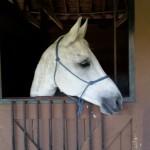
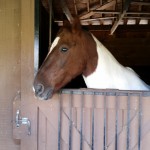
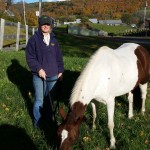
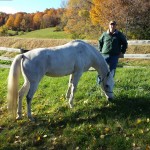
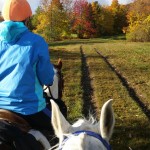
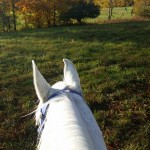
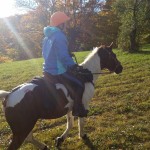

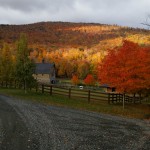
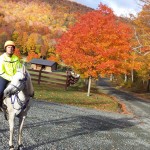
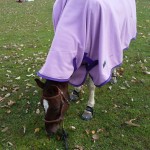
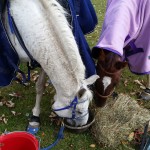
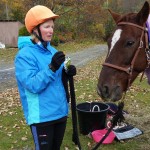
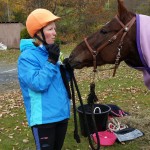
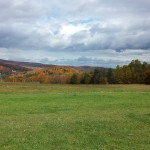
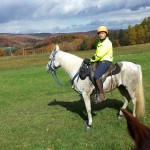
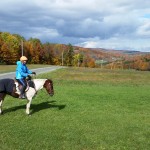
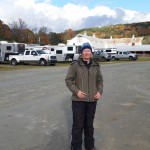

you are enjoying life to the fullest.so happy for you and your family .73s
great synopsis of the event!! I really enjoyed reading about your experience. Boy it was cold there!!! I guess you’re lucky you didn’t get more bad weather than you did!!! …and the elevation!! I got winded reading about it. 🙂 Congrats on doing such a great job with your training!!